Demands for Pay Equity Plaster the Costume Designers Guild Awards: ‘You’re Naked Without Us’

With the Oscars just around the corner, you could have easily mistaken the 26th Costume Designers Guild Awards for a late-season “Barbie” party. But the pops of pink, magenta, and fuchsia that met honorees and guests throughout NeueueHouse in Hollywood on February 21 weren’t nodding to the billion-dollar Best Picture bid; they were sending a message to the AMPTP.
“We’re fighting for pay equity with department creative heads that are mostly male,” Ariyela Wald-Cohain told IndieWire. The costume designer is one of four craftspeople helming the CDG’s Pay Equity Steering Committee. Her co-chairs Whitney Anne Adams, Danielle Launzel, and Daniel Selon were also in attendance — donning bright pink designs with emblems announcing their labor fight.
More from IndieWire
The 2024 Oscars Producers Preview Their All-Star Presenters, Kenergy, and '5,000 Jokes' to Cut Down
Warner Bros. Discovery to Shut Down Digital-Content Pioneer Rooster Teeth After 21 Years
“Our guild is 87 percent female, and we do believe it’s because costume design is considered ‘women’s work’ that we’re not getting equal pay,” Wald-Cohain said. “Our jobs are substantially similar, and we’re specifically talking about production designers and art directors.”
“We have to do this now because the wage gap keeps getting bigger every single year,” said Adams. The CDG, which expanded on its #NakedWithoutUs campaign by launching the Pay Equity Now initiative in January, argues that costume designers are paid nearly 30 percent less than male majority creative department heads when assuming a 60-hour work week. That’s despite doing jobs CDG members say require similar prep, work, and crew construction with results that massively impact a production’s success.
“One of the main things that we want to point out is how much we shape culture and how influential we are to everything that everyone buys,” Adams said. “Our work is very important on the storytelling angle, but it’s also important to culture as a whole.”
The annual awards event — honoring the best in costume design across film, TV, and short-form storytelling, with a new category added this year to honor costume illustration — took place less than two weeks before negotiations are set to begin between the Alliance of Motion Picture and Television Producers (AMPTP) and the International Alliance of Theatrical Stage Employees (IATSE) on Monday, March 4.
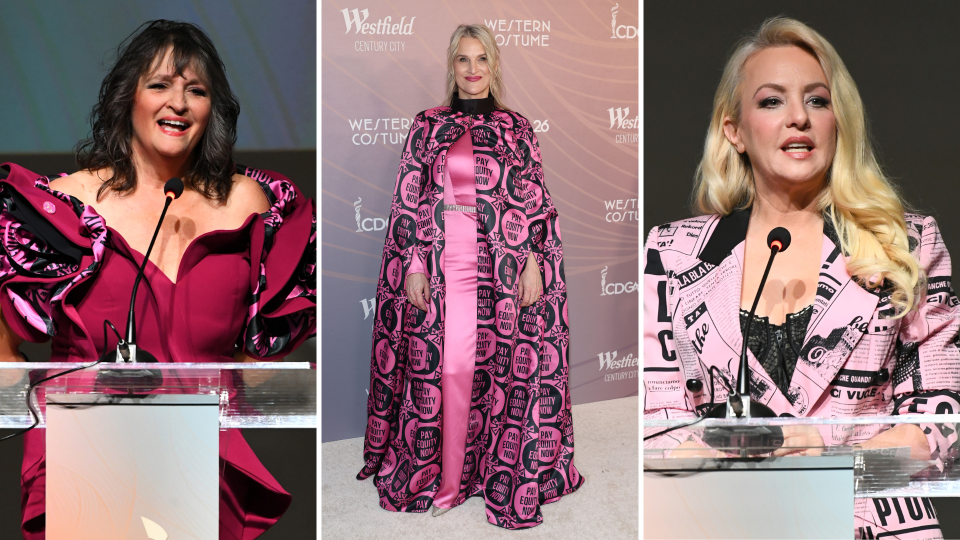
The threat of more strikes looms as various groups converge on producers to demand changes from the entertainment industry. Representatives for the AMPTP did not comment.
The SAG-AFTRA and WGA strikes of last year were more straightforward than the 2024 bargaining cycle will be, but the labor disputes should put just as big a squeeze on Hollywood. The CDG is one of 13 local guilds heading to the bargaining table to negotiate the IATSE Basic Agreement next month, and pay parity for CDG members is just one issue in that discussion. IATSE is simultaneously partnering with Teamsters Local 399 and the Basic Crafts unions to jointly negotiate the Motion Picture Industry Pension and Health Plan; the groups will bargain separately on other issues.
Still, the disparity in pay between men and women in Hollywood took centerstage on awards night, and the CDG delivered a clear message. President Terry Gordon opened her guild’s ceremony with a video from SAG-AFTRA President Fran Drescher (the designer and actor worked together on “The Nanny”), who encouraged members to stay strong in their fight and lean on their fellow unionized creatives. CDG Executive Director Brigitta Romanov echoed the actress’ statements.
“Let us recommit ourselves to the ongoing fight for justice, equality, and dignity for all workers — and a future where every worker is treated with the respect and dignity they deserve,” she said. Romanov wore a shiny shell-pink dress at the podium, but a Pay Equity Now-patterned cape on the red carpet; Gordon wore a dress in a deeper purple-pink (a metallic shade this reporter can’t name, but anyone there surely could).
“We have a history of gender disparity and therefore a pay inequity among costume designers, assistant costume designers, and costume illustrators, and it’s because the costume department’s work is viewed as ‘pink collar’ work,” Selon told IndieWire. “But that’s not true; that is old news. That is an old way of thinking, and we are moving into a new time.”
The only male co-chair of the Pay Equity Steering Committee, Selon described an emotional connection to his craft and feeling a responsibility to his peers.
“What I can bring to the table is what is subconsciously given to me. What I get is exactly what my female peers are denied, and that is respect and a higher wage,” he said, nodding to the ongoing gendered issues that persist even with the CDG. “There are many talented female costume designers, but I know they have to work twice as hard to achieve what a male costume designer achieves. And that is not right, and we are seeking to change that, and we are changing that.”
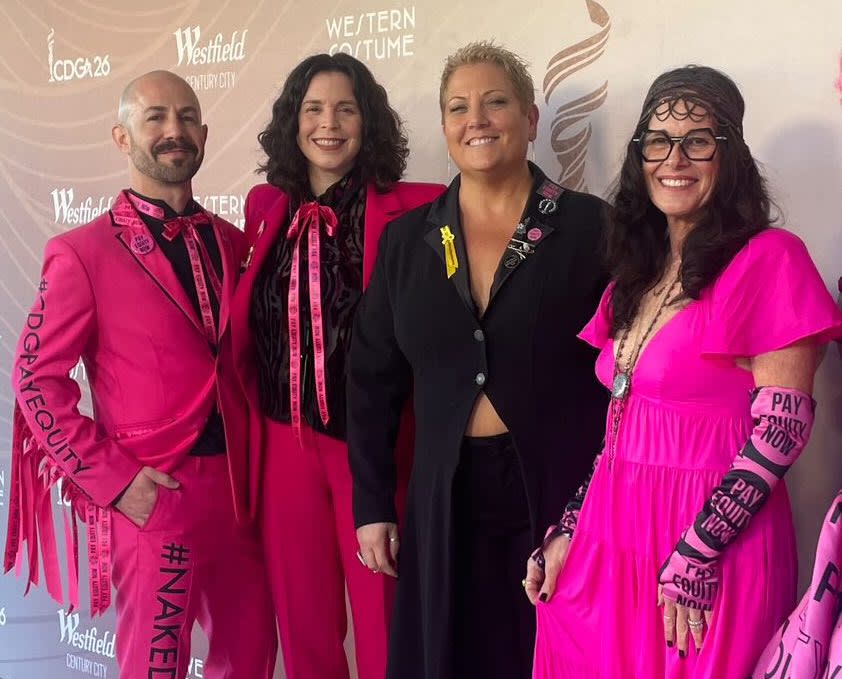
As difficult conversations ramp up at the bargaining table — and privately between producers and established designers already operating above the basic pay scale rate over which the CDG is arguing — the pressure to draw attention to pay parity is increasing.
The Pay Equity Now press release in January explains, “A stark gender pay gap continues to widen every year with the negotiated AMPTP cost of living increases. When each IATSE scale rate gets the same percentage increase annually it compounds to a much greater disparity between positions over time.” If true, that costume designers and, for example, production designers cannot dream of comparable retirements is an issue for creatives at the highest level of the art.
“I have to admit, while I was prepping to do this show, I was astounded to learn about the inequities in pay scale for costume designers,” said host Wendi McLendon-Covey. “Then, I did a little digging, and I realized, ‘Oh yeah, it’s because it’s a woman-dominated field.’ And God, I hate cliches.” The actress wore a pink suit and revealed a Pay Equity Now T-shirt to applause. Notably, the CDG has a long history of advocating for pay parity through fashion; designer Jenny Beavan even had a “Naked Without Us” embellishment on her sleeve when she won the Oscar for “Cruella” in 2022.
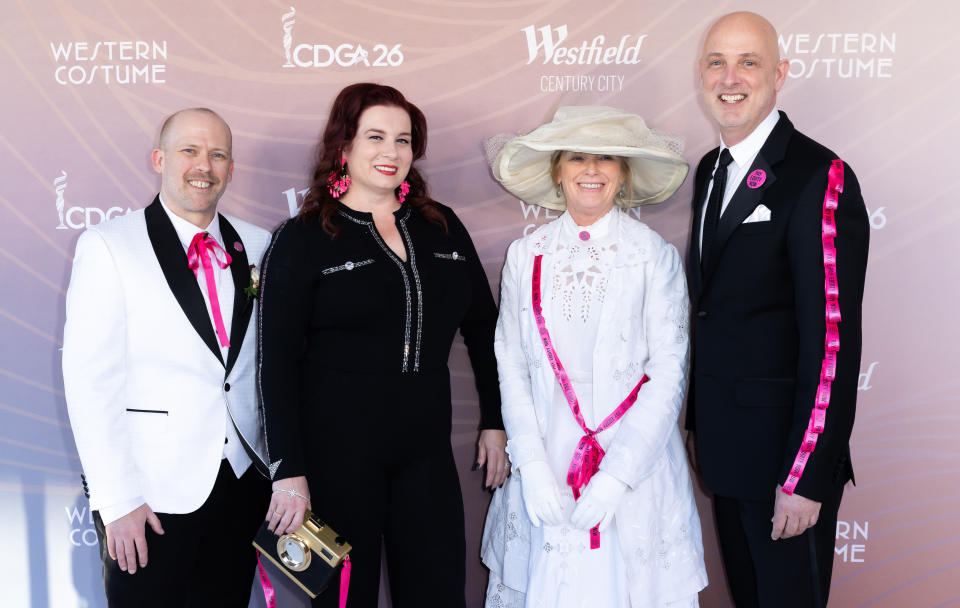
Annette Bening, who was not present, received the Spotlight Award for her career-long appreciation for and championing of costume design. The “Nyad” star chairs the board of the Entertainment Community Fund, which offers financial relief and mental health resources to actors and other creatives during labor disputes. She sent remarks, read by McLendon Covey.
“As IATSE goes to the bargaining committee later this year, we are here for you,” Bening wrote. “Because when it comes to costume design, it’s not just about finding the right dress for a character; it’s about having the strength of character to address the issues that ensure the ability to live one’s life as a creative professional.”
Endorsements from high-profile supporters — like, say, a Best Actress nominee — can prove critical to craftspeople getting power over producers during negotiations.
“With the actors, it’s difficult because everybody is asking them to do something. Everybody is asking for their support because they have such a strong voice,” Launzel, the fourth of the committee co-chairs, told IndieWire. “But the biggest compliment you can get is when an actor comes into the room, and you dress them, and they say, ‘Oh! Now, I know who this character is.’”
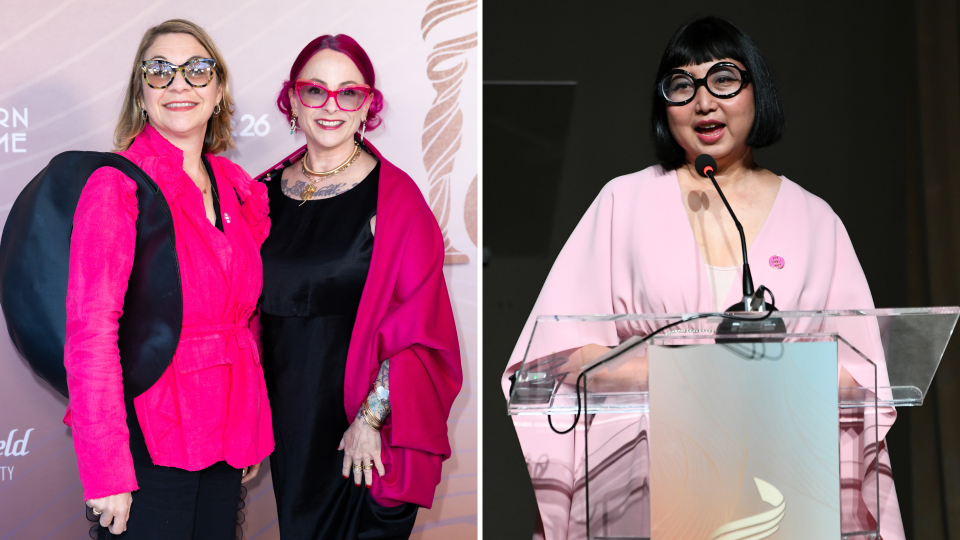
Sporting a one-legged, one-armed vintage Gaultier tuxedo — with a newly fashioned Pay Equity cummerbund and hat — costume designer Mandi Line commented on a lack of work during the strikes (“I wore this eight years ago… but we have to be on budget!”) and reported better compensation for costume designers on productions in Canada and Germany. The possibility of artists fleeing Hollywood for international markets is a buzzy conversation among producers.
“Costume designers really take the story to screen; we are storytellers above and beyond,” Line said. “I am down to work 16 or 18 hours, but I want to be paid the same as a production designer. It’s just time. At the end of the day, it’s not about being angry or being ugly or fighting — it’s just time to be paid what we deserve.”
“We are paid so much less because we are a female-oriented job,” said Erica D. Schwartz, an assistant costume designer who wore a massive, drag queen-inspired ball gown made in Pay Equity Now fabric. “We are fighting for pay equity because it is the law, and we haven’t gotten it in decades.”
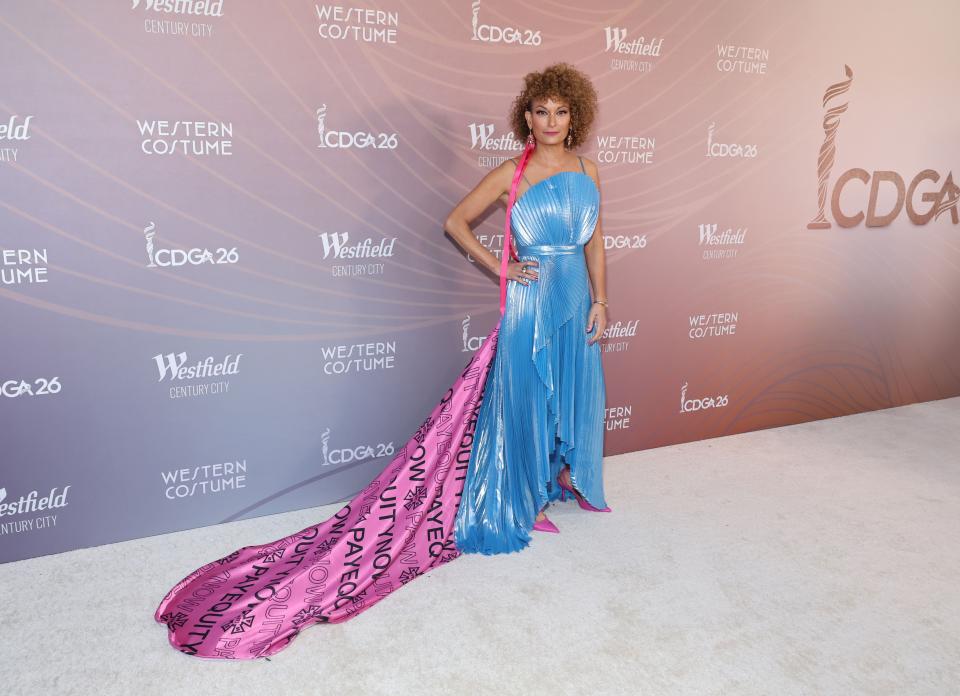
Even throughout that frustration, there was still a palpable passion for the craft.
“I wasn’t going to show up tonight because I’m so stressed out about a costume. I can barely think,” said Excellence in Short Form Design winner B. Åkerlund in her acceptance speech. The designer took home the prize for her short film with Madonna and Vanity Fair, wearing a pink puff gown and Pay Equity Now earrings.
“But then I thought, ‘Hey, I work really hard and I appreciate everyone that voted for me.’ And we need to remember to reward ourselves because I always put my job in front of myself. So here I am. I’m going to grab the award, and I’m going to go back to my job.”
Conversely, winning the first ever CDGA for Excellence in Costume Illustration, “Rebel Moon” visionary Jason Pastana punctuated his acceptance by reminding the audience he needed work.
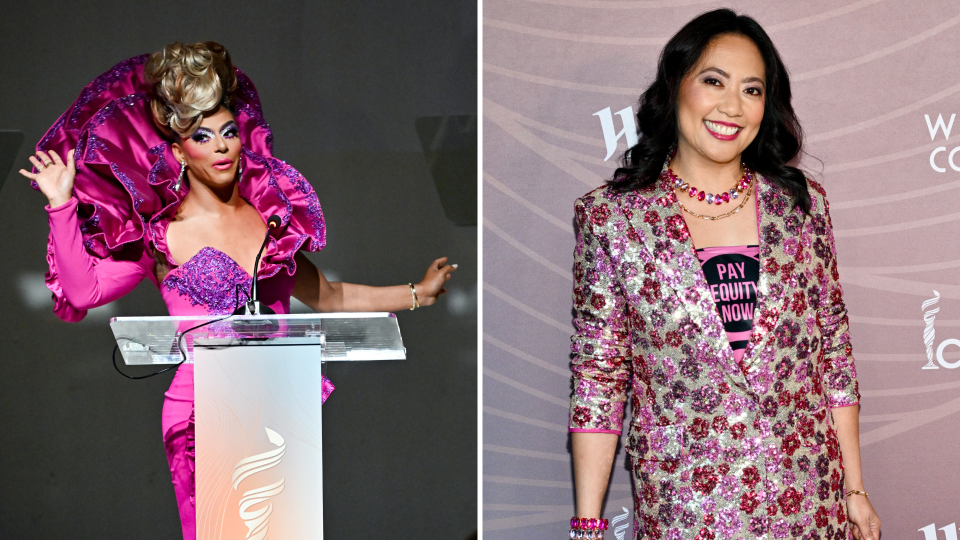
Jacqueline Duran snagged the CDGA statuette for Excellence in Sci-Fi/Fantasy Film for “Barbie”— ironically wearing black. When asked about the guild’s use of pink and the Barbie of it all, Launzel said she hadn’t really put Pay Equity Now and the Mattel movie together.
“But I will say, the whole conversation around America Ferrara’s monologue and character explains exactly what we do and how we feel about what we do,” the designer said. “Being a woman is a beautiful thing, but it’s also really effing hard. And if I was a man, I could say fucking.”
Asked the same, Line popped off her self-made hat. The costume designer has had short pink hair for years and cites not Mattel but Janelle Monáe as inspiration.
“Pink,” she said, “is my favorite color.”
Best of IndieWire
The 65 Best Sci-Fi Movies of the 21st Century, from 'Melancholia' and 'M3GAN' to 'Asteroid City'
Christopher Nolan Movies, Ranked from 'The Dark Knight' and 'Tenet' to 'Dunkirk' and 'Oppenheimer'
Where to Watch This Week's New Movies, Including 'Argylle' and 'How to Have Sex'
Sign up for Indiewire's Newsletter. For the latest news, follow us on Facebook, Twitter, and Instagram.

 Yahoo Finance
Yahoo Finance 